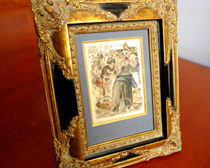Archived Content
In an effort to keep ICE.gov current, the archive contains content from a previous administration or is otherwise outdated. This information is archived and not reflective of current practice.
TOP STORY: Cultural property investigations span the globe
Criminals have illegally traded cultural art and antiquities for as long as history dates. Today, illicit trafficking of cultural items has become an $8 billion business that knows no borders.
Federal importation laws task U.S. Immigration and Customs Enforcement's (ICE) Homeland Security Investigations (HSI) with investigating crimes related to the illicit importation and distribution of cultural property and art. These laws permit HSI to seize cultural property and art brought into the United States, especially when objects have been reported lost or stolen.
"These objects are important parts of the culture and history of countries," said Special Agent Craig Karch. "Many of these objects are some of the most important pieces that ever get discovered."
In January, HSI repatriated a monotype, a one-of-a-kind print made by painting on a sheet or slab of glass and transferring the still-wet painting to a sheet of paper. This monotype was stolen from a French museum in 1981. Special agents discovered it prior to a Sotheby's New York auction. In February, HSI and U.S. Customs and Border Protection returned eight Mayan artifacts to the Guatemalan government. The artifacts were illegally exported from Guatemala and date back to 600 to 900 A.D. Later this month, HSI will return "Christ Carrying the Cross Dragged by a Rogue," a painting stolen by Nazi sympathizers from a Jewish-Italian family during World War II, to its rightful owners.
"We have a tremendous responsibility that transcends us as people, institution or country in returning cultural property to its country of origin or rightful owner. These objects are irreplaceable, not souvenirs or trophies," said Program Manager Debbie Hardos. "It's the right thing to do."
Since 2007, ICE and U.S. Customs and Border Protection have repatriated more than 2,500 objects to more than 23 countries. Karch credits an increase in public awareness for the increase in investigative leads.
"The more people who know that HSI conducts these investigations, the more leads we receive and the better chance we have of returning illicitly trafficked cultural property or art to their rightful owners," said Karch.
Learn more about cultural property, art and antiquities investigations.



